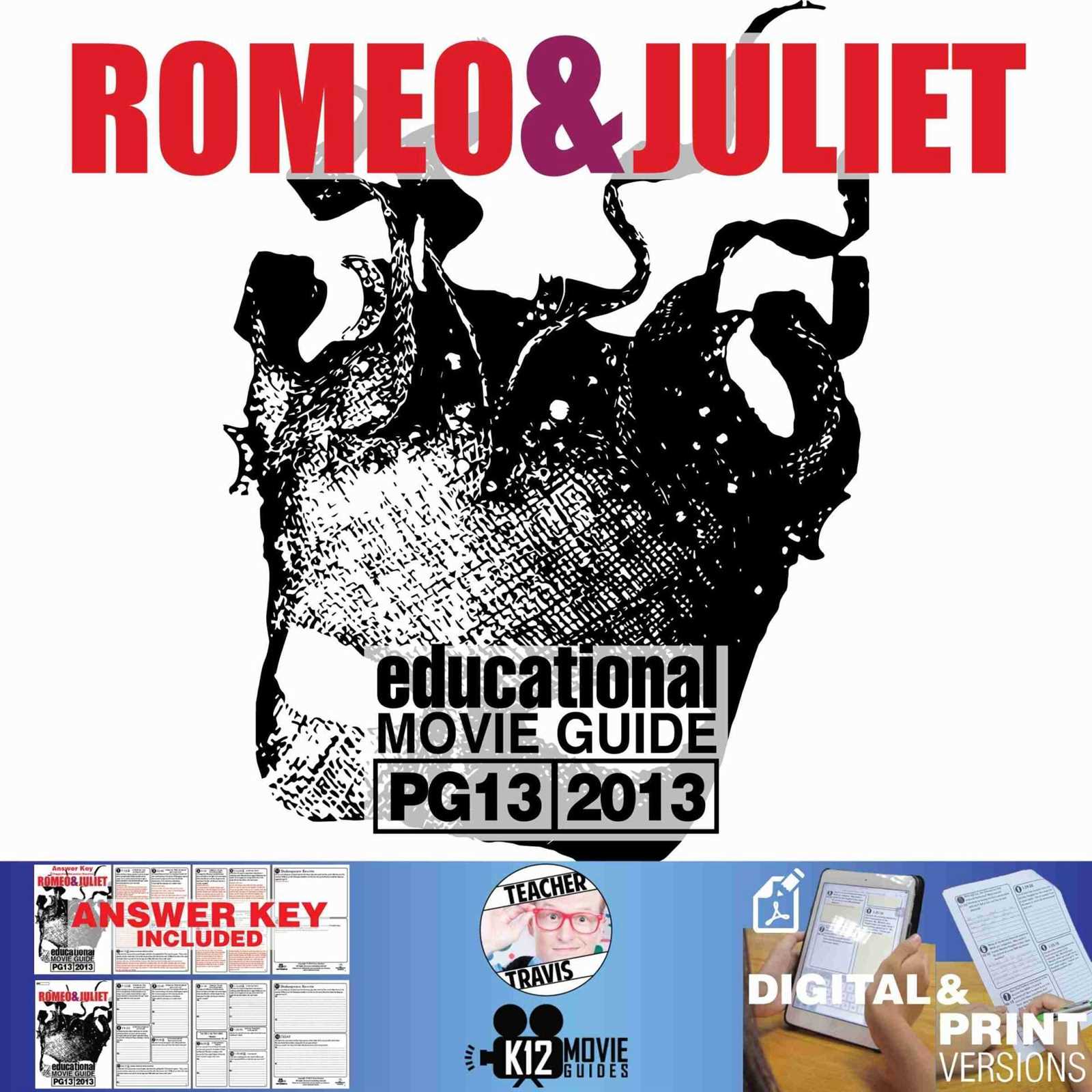
In this section, we delve into the fundamental aspects of a renowned literary work. The focus is on understanding its central themes, significant characters, and the dramatic events that shape the narrative. By examining the motivations behind each action and the deeper meanings embedded within the plot, we aim to provide a comprehensive analysis that enhances the reader’s appreciation of this timeless story.
Unraveling the complex relationships is essential to grasp the emotional depth and moral lessons presented. The tensions between opposing forces, such as love and conflict, drive the characters toward inevitable decisions, culminating in a resolution that leaves a lasting impression on audiences. Through this exploration, we invite readers to gain a deeper understanding of the forces that shape the lives of the protagonists.
Key elements such as fate, loyalty, and family dynamics are interwoven throughout, offering rich layers of meaning that resonate far beyond the confines of the narrative. By reflecting on the interplay between these factors, we can better appreciate the choices made by the characters and the consequences of their actions, leading to a greater understanding of the themes at the heart of this classic work.
Key Themes in Romeo and Juliet
At the heart of this timeless tragedy lie several important motifs that drive the emotional and moral dimensions of the story. The exploration of love versus conflict, along with the inevitability of fate, shapes the trajectory of events and influences the characters’ actions. These core ideas are not only central to the plot but also reflect universal truths about human experience, making this work resonate with audiences across time and cultures.
Love and Passion
One of the dominant themes is the intensity of love and its capacity to transcend social barriers. The powerful emotions of the central characters lead them to defy family expectations, and their devotion to one another becomes both a source of strength and a catalyst for tragedy. This passionate connection highlights the idea that love, while beautiful, can also be destructive when it exists in a world of division and discord.
Fate and Destiny
Another recurring theme is the inescapable force of fate. From the outset, the audience is aware of the tragic end awaiting the protagonists, and throughout the narrative, the characters struggle against the concept of destiny. This interplay between free will and preordained outcomes adds a layer of complexity, questioning whether the characters are the architects of their own doom or merely victims of external forces.
| Theme | Significance |
|---|---|
| Love | Creates the foundation of the story but also leads to the characters’ downfall. |
| Conflict | Drives the wedge between families, influencing characters’ decisions. |
| Fate | The characters’ belief in their predetermined end influences their actions. |
| Youth | Represents the impulsive nature of young love and decision-making. |
These themes not only provide depth to the narrative but also challenge the audience to reflect on the nature of love, choice, and the consequences of human actions. By exploring these elements, the story invites contemplation on how these forces continue to shape relationships and societies across generations.
Understanding the Tragic Hero Archetype
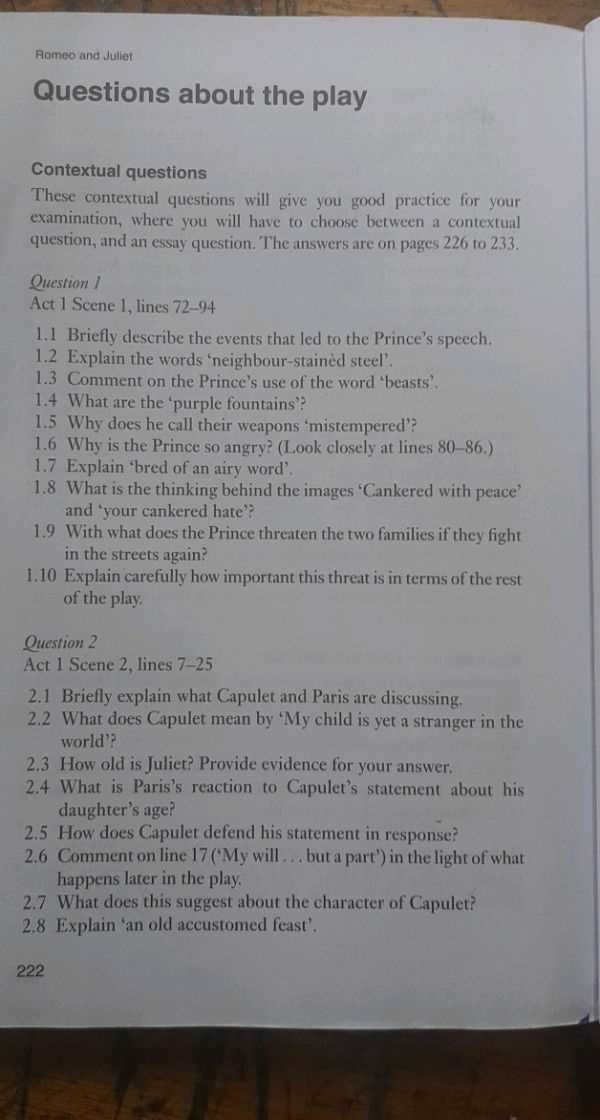
The tragic hero archetype is a timeless literary figure characterized by their noble qualities, yet destined for downfall due to a fatal flaw or error in judgment. These protagonists evoke sympathy from the audience as they struggle with internal and external conflicts, often leading to irreversible consequences. This figure embodies the complexity of human nature, where greatness and weakness coexist, and their tragic fate becomes inevitable as their flaws drive them toward their ultimate end.
At the core of the tragic hero’s journey is a profound sense of self-awareness and realization. As the story unfolds, the character often comes to understand the consequences of their actions, but by then, it is too late to alter their path. This knowledge, while cathartic, is also part of what makes the hero’s fate so compelling, as the audience shares in the tragic inevitability that awaits.
In the context of this timeless narrative, the tragic hero archetype reflects the human experience–our strengths and vulnerabilities, our decisions and their outcomes. The flawed nature of the protagonist makes them relatable, yet their inevitable fall from grace underscores the consequences of unchecked passion, ambition, or rashness.
Main Characters and Their Motivations
The core of any powerful narrative lies in the characters and the driving forces behind their actions. In this story, the central figures are shaped by strong desires, family loyalty, and the pursuit of personal happiness, often leading to profound consequences. Their motivations create both the emotional depth and the conflict that propel the plot, highlighting the impact of personal choices in a world defined by division and tradition.
One character’s actions are driven by a longing for connection and defiance against societal expectations, while another seeks to maintain family honor and peace. The contrast between these desires fuels the tragic tension that unfolds. As they navigate a world of forbidden love, family loyalty, and individual ambitions, their motivations become the catalyst for the dramatic turns of the story.
Each character’s internal struggle reveals deeper themes of passion, identity, and consequence. These emotional drives, whether based in love, duty, or pride, shape their decisions, leading them to either clash with others or make sacrifices that affect their futures. Ultimately, their motivations intertwine to create a narrative where personal goals collide with the harsh realities of their environment, resulting in a story that resonates with universal truths about human nature.
Exploring Romeo’s Journey and Growth
The evolution of a young protagonist serves as a central pillar in many narratives, as it reveals their transformation from impulsive youth to a more self-aware individual. This character’s journey is marked by intense emotional experiences, which shape his decisions and reveal his inner conflict. From moments of blind passion to instances of self-reflection, his development reflects the complexities of growing up and facing the consequences of one’s actions.
At the beginning, he is driven by deep emotions and quick decisions, often acting without considering the long-term implications. However, as the story progresses, he begins to confront the weight of his choices. This transition is a crucial aspect of his journey, showcasing a shift from naive impulsiveness to a painful understanding of the harsh realities surrounding him.
By the end, his growth becomes evident as he experiences both profound love and devastating loss. Through these experiences, he learns the painful lessons that come with the complexity of human relationships, loyalty, and fate. The character’s progression is a powerful reflection of the transformation that many individuals undergo as they navigate life’s challenges and confront their own limitations.
The Role of Fate in the Story
Throughout the narrative, the concept of destiny plays a crucial role in guiding the characters’ actions and shaping the events that unfold. From the outset, it becomes clear that the protagonists are caught in a web of unavoidable circumstances that lead them toward an inevitable end. This overarching force dictates much of their behavior, with decisions seemingly influenced by something beyond their control, often making their struggles feel preordained.
The idea of fate manifests in various ways, from the early forewarnings to the tragic coincidences that contribute to the characters’ downfall. The notion that certain outcomes are written in the stars adds a layer of inevitability to the plot, intensifying the emotional weight of the narrative. Characters, while making choices that appear independent, seem to be steered by forces beyond their comprehension.
As the story progresses, the characters’ increasing awareness of their fate amplifies their internal conflicts. They are torn between resisting their predetermined path and accepting the consequences of their actions. In the end, the theme of fate underscores the tragedy of the tale, as the protagonists’ attempts to control their destinies only seem to hasten their tragic end, reflecting the tension between free will and destiny.
How Family Feuds Shape the Plot
Central to the narrative is the intense conflict between two powerful families, whose ongoing feud sets the stage for the entire story. This bitter rivalry influences the decisions, relationships, and actions of the characters, creating a volatile atmosphere where love, loyalty, and honor collide. The families’ deep-rooted animosity not only drives individual characters but also acts as a catalyst for the tragic events that unfold.
The constant tension between these groups heightens the stakes, making every interaction between characters fraught with danger and uncertainty. The feud forces individuals to make choices that would not have been made in a different context, leading them to act impulsively, often in ways that harm themselves or others. The destructive nature of the conflict is reflected in the characters’ fates, as their attempts to overcome the barriers created by family loyalty and hatred ultimately contribute to their downfall.
As the plot progresses, the impact of the family feud becomes even more evident. What begins as a personal dispute grows into a larger force that influences the lives of all involved. The families’ inability to reconcile or put aside their differences seals the tragic fate of the characters, highlighting the theme of division and the far-reaching consequences of unresolved conflict.
Juliet’s Transformation Throughout the Play
As the narrative unfolds, one of the most compelling aspects is the evolution of a young woman from innocence to a deeper understanding of love, sacrifice, and duty. What begins as a naive, obedient daughter gradually shifts into a determined and independent figure, willing to defy societal norms for personal conviction. This transformation is crucial, not only for the character’s development but also for the story’s emotional depth and intensity.
The Shift from Innocence to Maturity
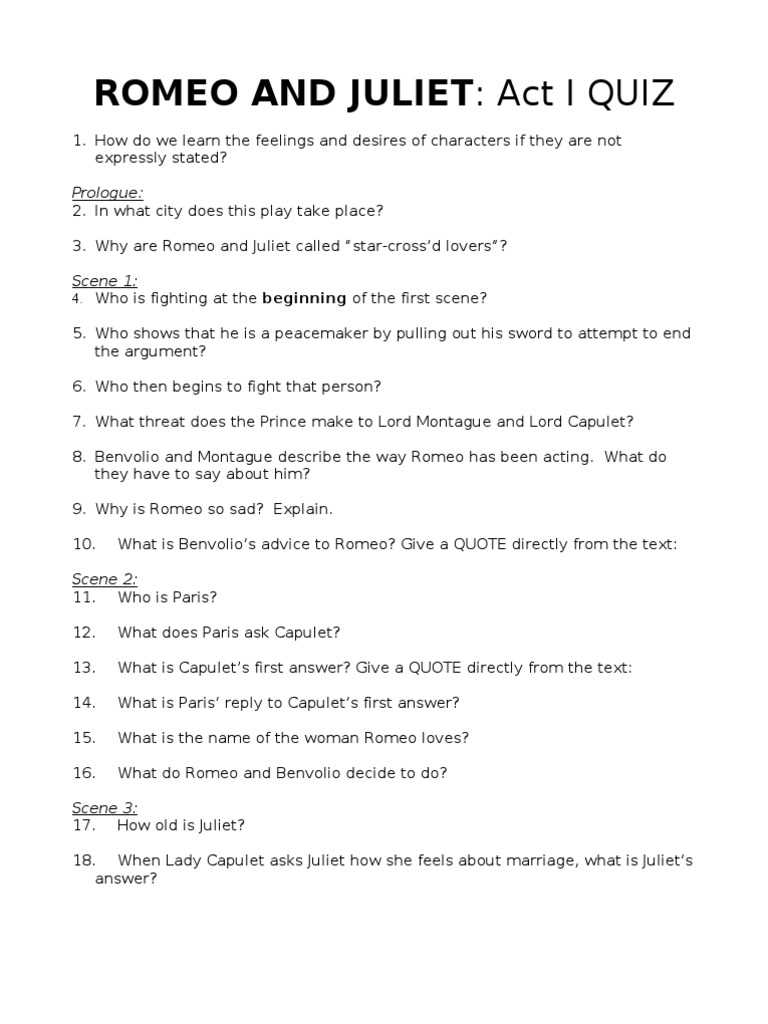
At the start, she is portrayed as a sheltered, idealistic girl, whose future seems controlled by the expectations of her family. Her initial encounters with love and relationships are naive, with her focus being more on outward appearances and societal expectations than personal desires. However, as the story progresses, she begins to question her role and the path that has been laid out for her, leading her to make bold decisions that reflect her inner growth.
Defiance and Sacrifice
By the end of the narrative, the transformation is complete as she becomes a figure of defiance and ultimate sacrifice. No longer passive or resigned to her family’s wishes, she takes control of her own fate, even when faced with impossible choices. This newfound strength underscores the central themes of the narrative, showcasing the complexity of love, loyalty, and personal agency in a world governed by rigid social structures.
Significance of the Balcony Scene
The iconic scene set upon a balcony is a pivotal moment in the narrative, representing the intersection of love, secrecy, and tension. It is within this intimate setting that the relationship between the two leads deepens, revealing the emotional intensity of their connection. This scene also marks a turning point in their lives, as it symbolizes both their love’s purity and the obstacles that come with it.
- Symbolism of Separation: The physical distance between them represents the societal divide that keeps them apart. The balcony serves as a metaphor for the separation of their worlds.
- Love and Passion: This moment highlights the growing emotional and physical attraction between the characters. The scene is filled with poetic dialogue that elevates the depth of their affection.
- Secrecy and Risk: The secret nature of their conversation and the risks they take to communicate underscore the sense of forbidden love. It emphasizes their willingness to defy family expectations for their personal desires.
- Foreshadowing Tragedy: Although the scene is filled with romance, it subtly hints at the impending obstacles and tragic outcomes that will result from their love.
In this scene, love is portrayed as both beautiful and dangerous, where the characters’ emotional honesty is juxtaposed with the looming threats surrounding them. This combination of tender affection and impending doom makes the balcony scene one of the most powerful and memorable moments in the narrative.
Understanding the Play’s Setting
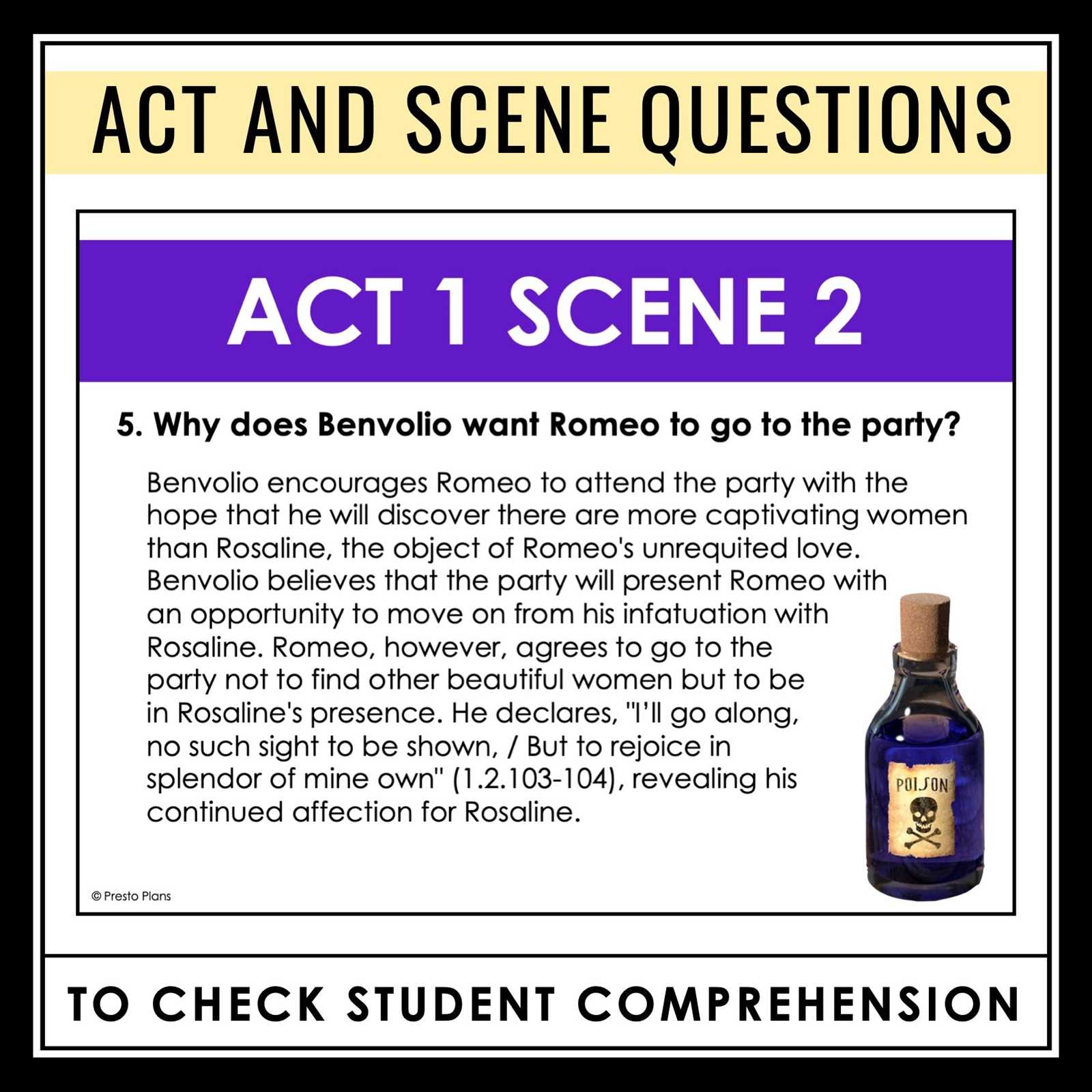
The backdrop of the narrative plays a crucial role in shaping the events and the characters’ actions. The environment is not just a passive space but actively influences the tone and the decisions made throughout the drama. The social, political, and geographical landscape of the setting provides context for the characters’ struggles, motivations, and relationships.
- Verona’s Influence: The city itself is central to the conflict. The long-standing feud between two influential families creates an atmosphere of tension and hostility, affecting every interaction.
- Social Structure: The rigid class system in place dictates behavior and interactions, often limiting personal freedom and creating barriers between individuals who might otherwise connect.
- The Impact of Public Spaces: Key locations, such as the marketplace or the streets, symbolize the constant presence of conflict. These open areas are where many critical events unfold, further emphasizing the public nature of the drama.
- The Role of Private Spaces: In contrast, intimate moments occur in more secluded settings, like balconies or private chambers, where characters can express themselves more freely but still face the consequences of their actions.
The setting not only provides physical locations for the events but also shapes the emotional and psychological landscape of the characters. It acts as a silent yet potent force, influencing the narrative and its tragic resolution.
The Impact of Verona on the Story

The city of Verona is more than just a backdrop; it is a vital force that shapes the actions and fates of the characters. The social, political, and physical environment of Verona deeply influences the unfolding of events and contributes to the tension and tragedy that permeate the narrative. The urban setting is not neutral, but rather an active participant in the unfolding drama.
Social Division and Conflict
- Family Rivalries: The longstanding feud between two prominent families creates an atmosphere of hostility and division, where individuals are forced to choose sides, often at the cost of their own happiness.
- Public vs. Private Spaces: The city’s public spaces, such as the streets and marketplaces, are arenas of conflict, while more private, intimate spaces provide moments of refuge, but with the constant threat of external forces infringing on personal lives.
- Law and Order: Verona’s legal and social systems reinforce the power struggles between the families, adding pressure on the characters to act within rigid boundaries that often result in tragic consequences.
The Geographical Influence
- Physical Boundaries: The city’s layout, including key locations like the Capulet house or the church, serves as a stage where characters’ movements and decisions are constrained by their surroundings.
- Symbolic Significance: Verona is also symbolic of larger societal forces–its walls and divisions reflect the emotional barriers that the characters must face, making it a metaphor for both physical and emotional confinement.
The city of Verona provides not only the setting for key events but also an essential context that shapes the choices and fates of the characters, adding layers of complexity to the overall story.
Symbols and Motifs in Romeo and Juliet
The play is rich with symbols and recurring motifs that deepen its meaning and reflect the themes explored throughout the narrative. These elements serve as more than mere decorative features; they carry emotional weight and reveal underlying truths about the characters, their desires, and the world they inhabit. By examining these symbols and motifs, one can uncover a deeper understanding of the tragedy.
Key Symbols
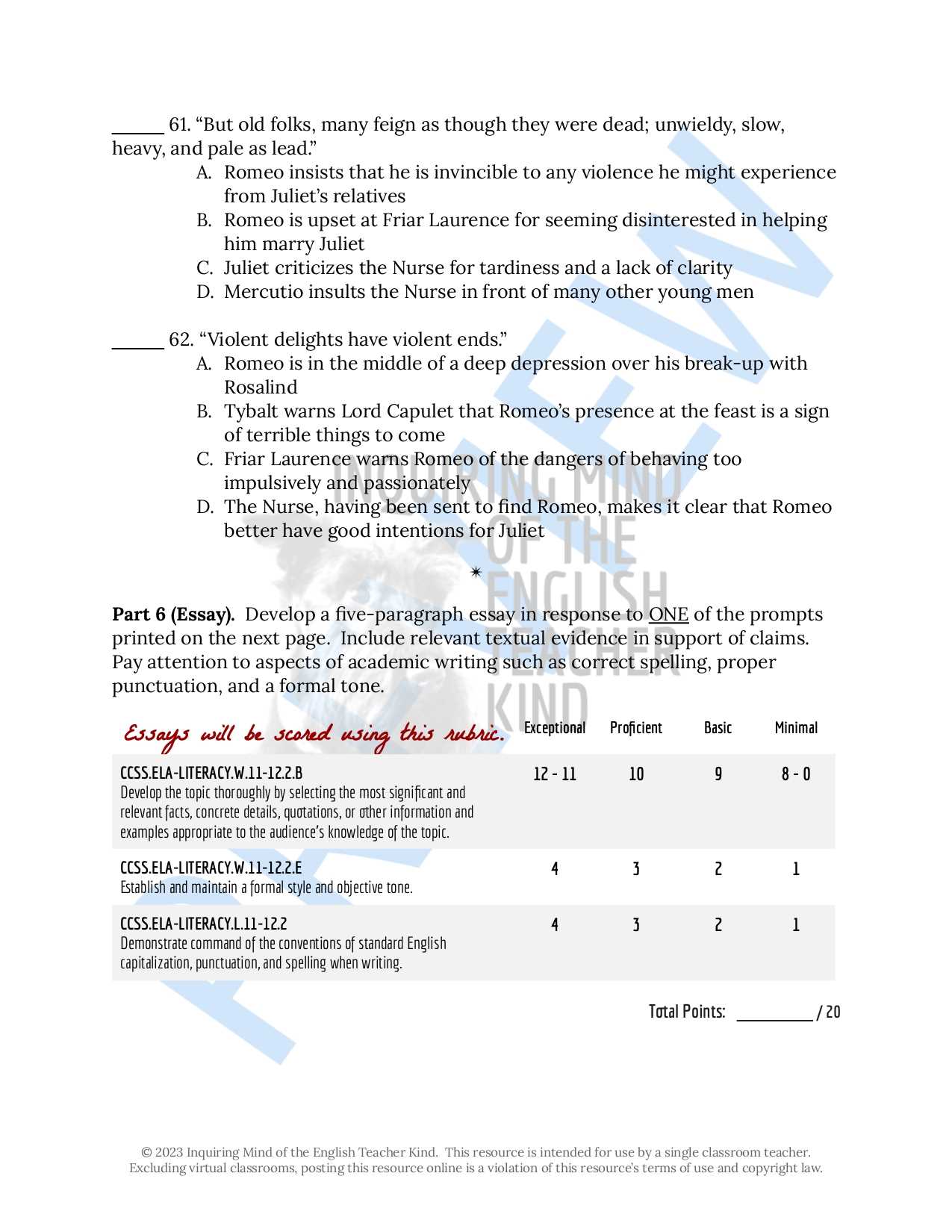
- Light and Darkness: The contrast between light and darkness is frequently used to symbolize the tension between love and hate, life and death, and hope and despair. Light often represents love and purity, while darkness is linked to danger, secrecy, and eventual doom.
- Poison: Poison symbolizes both the destructive power of hate and the tragic inevitability of the characters’ fate. It plays a crucial role in the characters’ actions and serves as a potent reminder of the fragile nature of life.
- Flowers: Flowers, particularly roses, symbolize beauty, transience, and the fleeting nature of life. They also represent the delicate relationship between beauty and death, as seen in the characters’ interactions and ultimate demise.
Recurring Motifs
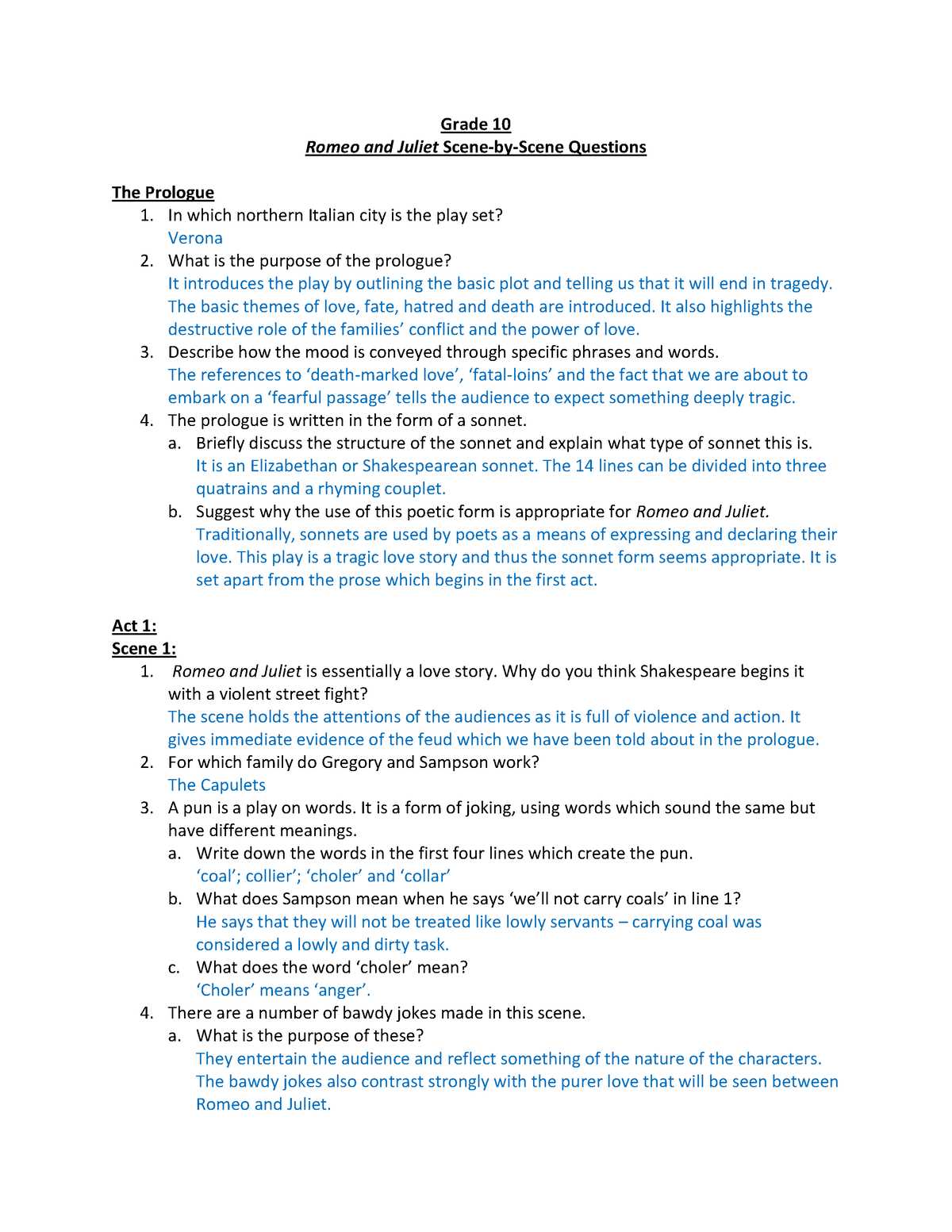
| Motif | Meaning |
|---|---|
| Fate | The idea of destiny and inescapable fate is a recurring theme that drives the characters’ actions. The characters often refer to their “star-crossed” fate, suggesting that they are powerless against a predetermined course. |
| Youth | Youth is portrayed as both a source of passion and impulsiveness, but also as a tragic flaw that leads to hasty decisions and consequences. The youthful energy of the characters shapes their emotional journey and the unfolding of events. |
| Time | Time is another important motif, representing both the urgency of love and the fleeting nature of life. The rapid pace of events suggests that time is both a blessing and a curse, especially as the characters rush toward their inevitable end. |
These symbols and motifs not only enrich the story but also serve as keys to understanding the emotional depth and thematic complexities within the narrative. They underscore the tragic nature of the events and offer insight into the motivations of the characters, their environment, and the societal pressures that shape their destinies.
The Meaning of Light and Darkness
Throughout the story, light and darkness are powerful metaphors that reflect the internal and external conflicts faced by the characters. These opposing elements symbolize the contrast between opposing forces–good and evil, love and hate, life and death. The recurring imagery of light and darkness serves as a lens through which the audience can interpret the emotional tone and the trajectory of the characters’ destinies.
Light as a Symbol of Purity and Love
Light is often associated with purity, hope, and the beauty of love. It represents moments of clarity and connection, offering a glimpse of something transcendent amidst the turmoil of life. In certain scenes, light is used to portray the innocence and passion of love, where characters find solace and joy in each other’s presence, even as they face overwhelming challenges. The imagery of light in these instances highlights the fragile, yet radiant, nature of the bond between the lovers.
Darkness as a Symbol of Conflict and Fate
Darkness, in contrast, is frequently tied to danger, secrecy, and the looming presence of inevitable doom. It represents the unknown, where characters are confronted by external forces that threaten their love and their lives. Darkness often marks moments of separation, secrecy, or the tragic events that unfold. It symbolizes the emotional and physical distance that grows between the lovers, even as they try to remain united against all odds. Ultimately, the darkness reinforces the theme of fate, suggesting that the end is inescapable.
The interplay between light and darkness throughout the narrative underscores the fleeting nature of happiness and the inevitability of sorrow. These elements highlight the emotional extremes that define the tragic journey and offer a poignant reflection on the forces that shape the characters’ lives and destinies.
Language and Poetry in the Play
The use of language in the narrative is not merely functional, but also an essential means of expressing the deep emotions, themes, and character relationships. The poetic nature of the dialogue enhances the emotional resonance of key moments and underscores the intensity of the characters’ feelings. From the eloquent exchanges between lovers to the impassioned speeches of conflict, the play’s language transforms every scene into a vibrant tapestry of words.
Expressive Power of Verse
Poetry is a central element in shaping the tone of the story. The lyrical quality of the dialogue elevates simple conversations into artful expressions of emotion. Characters often speak in verse, especially during significant moments, such as declarations of love or moments of crisis. The meter and rhythm of the verse give the words a musicality that enhances the emotional depth, making each line feel purposeful and charged with meaning.
Metaphors, Puns, and Wordplay
Metaphors and wordplay are frequent in the dialogue, adding layers of meaning to seemingly straightforward statements. For example, the use of metaphors comparing love to light, fire, or a flame enriches the audience’s understanding of the characters’ inner worlds. Similarly, puns and playful language serve to highlight the contrast between innocence and cynicism, lightheartedness and tragedy. These linguistic techniques create a dynamic interplay of meaning, making the text both engaging and thought-provoking.
The language in the play transcends simple communication, becoming an integral part of the narrative’s emotional landscape. Through the power of poetry, characters are able to express their deepest passions, fears, and desires in ways that resonate far beyond the spoken word.
Examining the Use of Shakespearean Dialogue
Shakespeare’s distinctive use of dialogue plays a crucial role in developing character, advancing the plot, and conveying the emotional intensity of the narrative. The language in this play is far from ordinary conversation; it is rich with metaphor, rhythm, and intricate structures that elevate the simplest exchanges into powerful expressions of human experience. Each line is carefully crafted to reveal the nuances of relationships and the inner struggles of the characters, making the dialogue an essential tool for deepening the audience’s engagement.
The Power of Iambic Pentameter

One of the most notable features of Shakespeare’s dialogue is the frequent use of iambic pentameter, a rhythm pattern that mimics the natural flow of speech. This meter, composed of five pairs of alternating unstressed and stressed syllables, lends a musicality to the lines. When characters speak in iambic pentameter, it often signifies a moment of elevated emotion, such as love, anger, or despair. The meter’s regularity helps create a sense of harmony, while its deviations underscore moments of tension or surprise.
Metaphorical Language and Symbolism
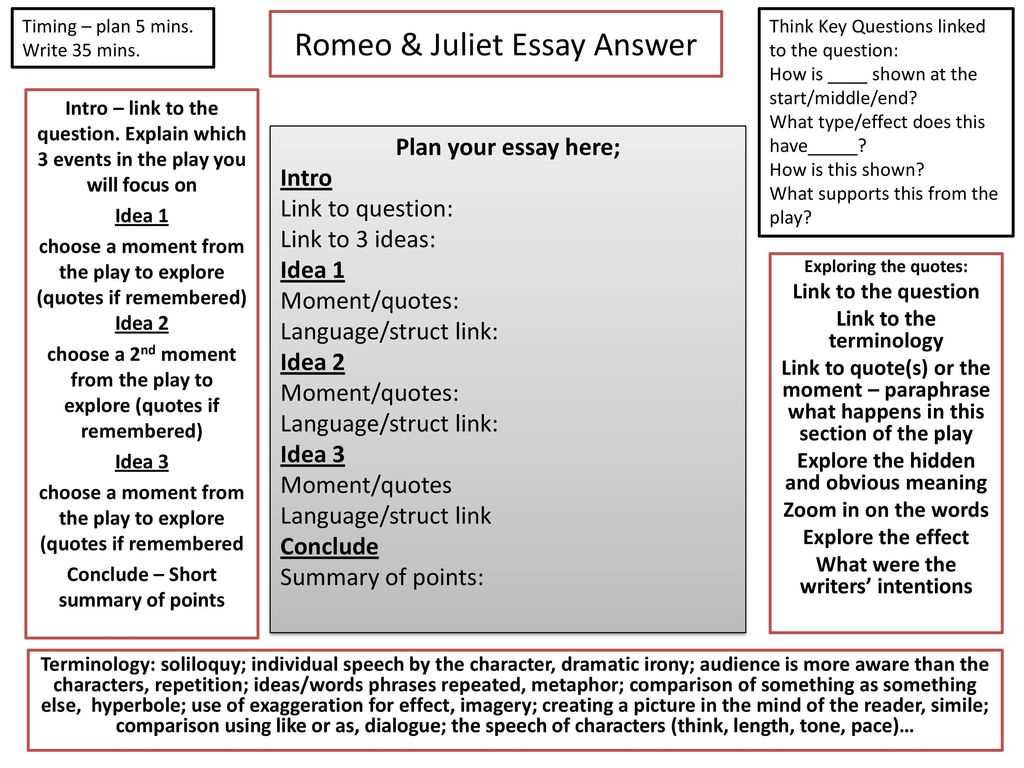
Shakespeare’s dialogue is also characterized by its extensive use of metaphor and symbolism. The playwright often employs figurative language to convey complex ideas and emotions. For instance, love is frequently compared to forces of nature, like light or fire, symbolizing both its beauty and its destructive potential. These comparisons deepen the thematic exploration of the narrative, adding layers of meaning to the dialogue that would otherwise remain unspoken.
The strategic use of Shakespearean dialogue is essential not only for its poetic quality but also for its ability to capture the essence of human nature, powerfully shaping the development of characters and plot while engaging the audience on an emotional level.
The Role of the Chorus in Romeo and Juliet
The chorus plays a significant role in guiding the audience through the narrative by providing insight, commentary, and context that deepen the understanding of the unfolding drama. Serving as both a narrator and a moral voice, the chorus introduces themes, foreshadows events, and reflects on the actions of the characters. Through their verses, they bridge the gap between the audience and the world of the play, offering a unique perspective on the events that shape the story.
One of the key functions of the chorus is to set the tone of the play and prepare the audience for the tragic fate of the characters. They often provide essential background information, ensuring that viewers are aware of the social and familial tensions that influence the unfolding events. Additionally, their reflections on fate and destiny allow for a deeper exploration of the themes of love, conflict, and the consequences of choices. By speaking directly to the audience, the chorus emphasizes the universal nature of the story, inviting them to reflect on the broader implications of the characters’ experiences.
In this way, the chorus is not just a passive observer but an active participant in shaping the narrative’s emotional and thematic depth, reinforcing the play’s central messages and adding layers of meaning to the drama.
How the Chorus Affects the Audience
The chorus plays a crucial role in shaping the audience’s emotional journey throughout the play. By offering commentary on the events, they provide context, introduce key themes, and heighten the dramatic impact of the unfolding story. Their presence serves as a reminder of the broader themes, ensuring that viewers remain aware of the central conflicts and moral lessons embedded in the narrative.
In many ways, the chorus acts as a guide, leading the audience through the emotional highs and lows of the plot. Their commentary often reflects on the inevitability of fate and the consequences of human choices. This creates a sense of anticipation, allowing the audience to reflect on the unfolding drama, while simultaneously distancing them from the immediate action of the characters. This distancing effect can make the audience more critical and thoughtful, prompting deeper reflections on the nature of love, violence, and social norms.
Emotional Engagement
- The chorus heightens the sense of tragedy by foreshadowing pivotal events, making the audience aware of the impending doom.
- Through poetic language, the chorus creates an emotional atmosphere, preparing the audience to empathize with the characters’ struggles and decisions.
Intellectual Reflection
- By summarizing events and offering moral commentary, the chorus encourages the audience to consider the larger implications of the characters’ actions.
- Their reflections on fate and destiny prompt viewers to question the nature of control and free will within the context of the play.
Overall, the chorus serves to amplify the emotional and intellectual engagement of the audience, adding a layer of depth to the play’s themes and helping to guide the viewer’s understanding of the story’s moral implications.
Love vs. Hate: Central Conflict
The central tension in the narrative revolves around the opposing forces of affection and animosity. These contrasting emotions shape the fate of the characters and drive the unfolding drama. As love flourishes in the midst of bitter hatred, the tension between these two forces becomes a defining aspect of the story, affecting not only the individuals involved but the entire community around them. This conflict is portrayed through interactions that range from moments of intense passion to instances of violent hostility, emphasizing the profound consequences of both emotions.
The Power of Love
Love serves as a transformative force in the story, offering moments of hope and unity. It creates bonds between individuals, but also leads to reckless decisions, illustrating the complex nature of affection.
The Destructive Nature of Hate
Hate, on the other hand, causes division and suffering, poisoning relationships and ultimately leading to tragic outcomes. The animosity between families acts as a catalyst for much of the story’s conflict, highlighting how destructive hatred can be when left unchecked.
| Emotion | Impact on the Story |
|---|---|
| Love | Unites characters, inspires actions, but also leads to impulsive decisions and tragic consequences. |
| Hate | Fuels conflict, causes harm, and ultimately results in irreversible loss. |
The ongoing battle between love and hate not only defines the personal struggles of the characters but also shapes the wider societal issues that permeate the play, ultimately leading to a powerful exploration of the human condition.
The Influence of Friendship on Decisions

Throughout the story, the bonds between friends play a significant role in shaping the choices characters make. These relationships provide both support and pressure, influencing individuals to act in ways that may not always align with their best interests. Friendship becomes a driving force behind many of the crucial decisions, often leading to actions driven by loyalty and personal connection rather than reason.
Support and Loyalty
Strong friendships provide characters with a sense of security and trust. This support often encourages individuals to take risks or make choices that they might not otherwise consider. The loyalty to friends can overpower other emotions, guiding characters to prioritize those bonds over personal safety or familial duties.
Peer Pressure and Consequences
At times, friendships can also lead to negative consequences. The influence of peers may push individuals into making impulsive or dangerous decisions. These choices, driven by the desire to please or impress friends, can result in dire outcomes that affect not just the individuals involved but those around them.
- Loyalty: Friends often influence each other’s actions through their trust and commitment.
- Influence: Strong friendships can pressure individuals into decisions they might not make alone.
- Consequences: While friends may offer guidance, their influence can lead to actions with serious repercussions.
In this way, the impact of friendship becomes a powerful motivator, shaping the decisions that drive the narrative forward. Friendships can be sources of both strength and vulnerability, illustrating the complex ways in which human connections affect individual choices.